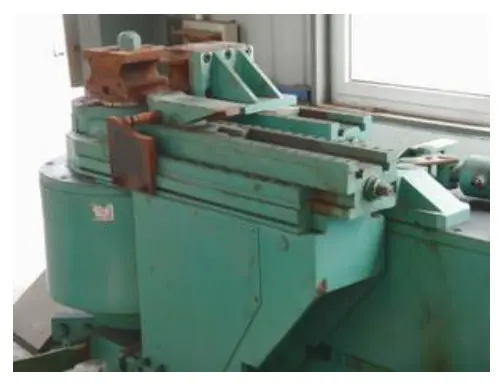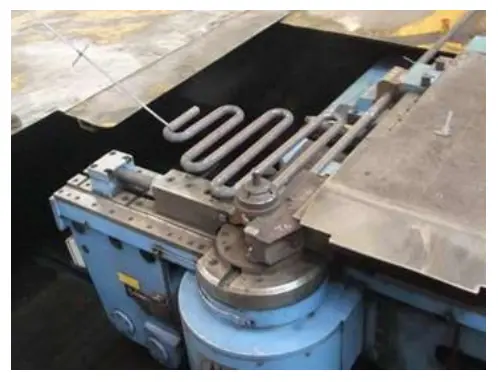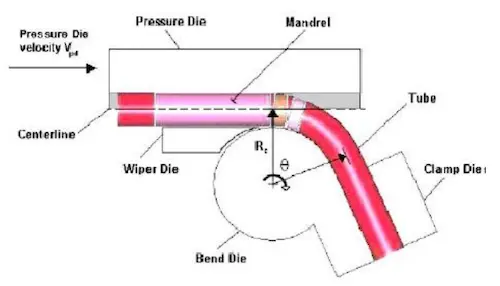Bends Used for Boiler Tubes
Posted: 06/25/2024 03:51:11 Hits: 39
1.1 Introduction
The power industry is a crucial foundational industry in the development of the modern economy. Currently, the three main forms of power generation are thermal power, nuclear power, and hydropower. In China's power industry, thermal power generation accounts for about 78% of the total electricity production. As one of the main components of thermal power units, power station boilers have always prioritized energy conservation and emission reduction. The Chinese government encourages the development of large-capacity, high-parameter, low-consumption, and low-emission units, leading to the shut down of some small-capacity units. As a result, power station boilers have gradually evolved to use higher-grade materials and more compact structures. The heating surface of the boiler is composed of tubes of various materials and specifications, coiled in various shapes within the boiler furnace. The boiler uses coal as fuel and heats the water vapor in the tubes through multiple stages to drive the turbine and generator, producing electricity. The development of power station boilers has progressed from low pressure to high pressure, ultra-high pressure, subcritical, supercritical, and ultra-supercritical. With the increase of boiler temperature and capacity, the heating surface tubes must use higher performance materials, and stricter requirements are imposed on the bends' performance to ensure safe operation.
Bends are common and critical components in the boiler heating surface. Their bending and forming are highly complex, resulting from the interaction of multiple factors. Power station boilers are typical high-temperature and high-pressure equipment, requiring stringent quality requirements for bends. In recent years, the development of power station boilers has introduced various small bending radius and thin-walled bends, creating difficulties in the bending process. Carbon steel, low alloy steel, high alloy steel, austenitic stainless steel, and other increasingly high-grade materials are used in boilers. Under the pressures of increased production capacity, labor, and material costs, boiler manufacturers are focusing more on bending process parameters and gradually shifting their focus from macroscopic dimensions to both macroscopic dimensions and microstructure in bend quality.
1.2 Processing methods and equipment for bends
There are many methods for bending pipes. According to the working mode of the pipe bending machine, they can be divided into winding bending, push bending, pressure bending, and rolling bending. According to whether there is filler in the pipe, they can be divided into core bending (filler bending) and coreless bending (no filler bending). According to the processing temperature of the workpiece, they can be divided into cold bending and hot bending. In recent years, with the advancement of forming technology, new methods such as thermal stress and laser bending have also emerged.
The pipe bending machine is the primary equipment used for pipe bending, and it has many structures. According to the bending method, pipe bending machines can be divided into winding, extrusion, and rolling types. Selection should be based on the number of parts, pipe size, wall thickness, metal material, and bending radius. Based on whether the pipe is heated during bending, machines can be classified as cold or hot pipe bending machines. Based on the transmission method, they can be divided into mechanical and hydraulic types. Based on the control method, they can be divided into manual control, semi-automatic control, and CNC pipe bending machines. In the boiler industry, considering adaptability to various pipe specifications and the reliability requirements of mass production, semi-automatic control or CNC hydraulic pipe bending machines are generally used, including hydraulic thick-walled pipe bending machines (Figure 1) and CNC top upsetting pipe bending machines (Figure 2).

Figure 1: Hydro Bending Machines
The power industry is a crucial foundational industry in the development of the modern economy. Currently, the three main forms of power generation are thermal power, nuclear power, and hydropower. In China's power industry, thermal power generation accounts for about 78% of the total electricity production. As one of the main components of thermal power units, power station boilers have always prioritized energy conservation and emission reduction. The Chinese government encourages the development of large-capacity, high-parameter, low-consumption, and low-emission units, leading to the shut down of some small-capacity units. As a result, power station boilers have gradually evolved to use higher-grade materials and more compact structures. The heating surface of the boiler is composed of tubes of various materials and specifications, coiled in various shapes within the boiler furnace. The boiler uses coal as fuel and heats the water vapor in the tubes through multiple stages to drive the turbine and generator, producing electricity. The development of power station boilers has progressed from low pressure to high pressure, ultra-high pressure, subcritical, supercritical, and ultra-supercritical. With the increase of boiler temperature and capacity, the heating surface tubes must use higher performance materials, and stricter requirements are imposed on the bends' performance to ensure safe operation.
Bends are common and critical components in the boiler heating surface. Their bending and forming are highly complex, resulting from the interaction of multiple factors. Power station boilers are typical high-temperature and high-pressure equipment, requiring stringent quality requirements for bends. In recent years, the development of power station boilers has introduced various small bending radius and thin-walled bends, creating difficulties in the bending process. Carbon steel, low alloy steel, high alloy steel, austenitic stainless steel, and other increasingly high-grade materials are used in boilers. Under the pressures of increased production capacity, labor, and material costs, boiler manufacturers are focusing more on bending process parameters and gradually shifting their focus from macroscopic dimensions to both macroscopic dimensions and microstructure in bend quality.
1.2 Processing methods and equipment for bends
There are many methods for bending pipes. According to the working mode of the pipe bending machine, they can be divided into winding bending, push bending, pressure bending, and rolling bending. According to whether there is filler in the pipe, they can be divided into core bending (filler bending) and coreless bending (no filler bending). According to the processing temperature of the workpiece, they can be divided into cold bending and hot bending. In recent years, with the advancement of forming technology, new methods such as thermal stress and laser bending have also emerged.
The pipe bending machine is the primary equipment used for pipe bending, and it has many structures. According to the bending method, pipe bending machines can be divided into winding, extrusion, and rolling types. Selection should be based on the number of parts, pipe size, wall thickness, metal material, and bending radius. Based on whether the pipe is heated during bending, machines can be classified as cold or hot pipe bending machines. Based on the transmission method, they can be divided into mechanical and hydraulic types. Based on the control method, they can be divided into manual control, semi-automatic control, and CNC pipe bending machines. In the boiler industry, considering adaptability to various pipe specifications and the reliability requirements of mass production, semi-automatic control or CNC hydraulic pipe bending machines are generally used, including hydraulic thick-walled pipe bending machines (Figure 1) and CNC top upsetting pipe bending machines (Figure 2).

Figure 1: Hydro Bending Machines
| Pipe diameters | 32 to 160mm |
| Pipe wall thickness | 3.5 to 12.5mm |
| Bending moment | 80KN.m |
| Roller clamping force | 25t |
| Upsetting force | 25t |
| Bending radius | R32 to R350 |
| Rotation angles | 187° |
| Angular repetition accuracy | ±0.2° |
| Speed | 0 to 5rad/s |
| Total machine weight | 25t |
| The designed unit | SCHWARZE from Germany |
The winding pipe bending machine is widely used in power station boiler manufacturing due to its simple operation and mature mold technology. Its working principle is shown in Figure 3. The pipe is constrained by various closely matched molds, mainly including bending molds, clamps, and back molds (or rollers). When bending thin-walled pipes, wrinkle-proof plates can be used to control the wrinkling on the inside. Some pipe bending machines have a push-back device. The pipe end is clamped between the clamp and the bending die. The middle of the bending die has a groove that matches the pipe's outer diameter and is designed according to the required bending radius. As the bending die rotates and the back mold limits movement, the clamp drives the pipe, wrapping it in the bending die’s groove. When the bending die rotates to the preset angle, the pipe completes the bending process. The hydraulic thick-walled pipe bending machine shown in Figure 1 uses a pair of rollers with grooves as the template. After the rollers are fitted with the pipe, their positions don’t change. They roll with the feeding of the pipe and usually do not have a push-back device. The equipment is simple and reliable, with high single-machine operation efficiency, and is suitable for various working conditions.

Figure 2: CNC upsetting bending machines
| Pipe diameters | 32 to 70mm |
| Pipe wall thickness | 3.5 to 12.5mm |
| Bending moment | 80KN.m |
| Roller clamping force | 10t |
| Bending radius | R40 to R350mm |
| Rotation angles | 210° |
| Angular repetition accuracy | ±0.2° |
| Pipe bending machine’s center height | 900mm |
| Speed | 0 to 2rad/s |
| Total machine weight | 18.8t |
| The designed unit | SCHWARZE from Germany |
The CNC bending machine shown in Figure 2 uses a platen-type mold. The platen with grooves moves along the feeding direction of the pipe during bending and has a CNC-adjustable back-thrust upsetting device. In some extreme cases, the roundness of the pipe bending part is better controlled, and the CNC system easily matches with the pipe welding and feeding devices to meet assembly line manufacturing. However, due to the equipment structure, it can only bend flat elbows, and it requires more movement steps. When manufacturing single-root bends and short pipes, its efficiency is not as good as that of hydraulic thick-walled pipe bending machines.

Figure 3: Working principles of pipe bending machines
Post URL: https://www.landeepipefitting.com/bends-used-for-boiler-tubes.html
Landee is a professional industrial pipe fitting manufacturer and be well accepted by customers all over the world, we has been producing Pipe Fitting for a variety of applications since 1985. welcome to access our website: https://www.landeepipefitting.com.
